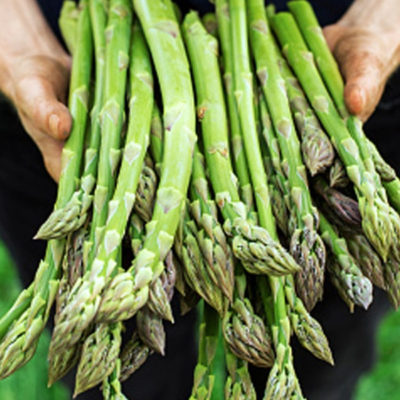
Learning Downloads: How to Grow Asparagus Seeds
From Seed to Harvest: A beginner’s guide to growing asparagus.
Gardeners are often daunted by growing asparagus from seed, a task accompanied by lengthy waiting periods and specific instructions. Yet, growing asparagus from seed is very possible and rewarding.
Not only delicious, hardy and a unique addition to any garden, asparagus is a perennials vegetable, returning year after year. To grow asparagus from seed, a gardener must provide adequate space, nurturing excessive patience. The first harvest typically occurs three seasons after the original planting.
To plant:
Asparagus seeds are often cheaper than pre-established roots, and producing a robust crop from seed is quite possible under the right conditions. To start, soak the seeds for a few hours. Gardeners are encouraged to begin their asparagus seeds in a greenhouse or somewhere indoors, planting the seeds a half-inch deep in soil temperatures of 70-85 degrees between the months of February and May. Each seed should occupy its own small pot. Sprouting will occur between two and eight weeks of planting.
To grow:
Transplant asparagus seedlings once they reach 10-12 weeks old, and frost dangers have passed. Plant seedlings approximately 18 inches apart in rows spaced 3 and 6 feet apart.
As the asparagus plant grows, cover its crown with soil and keep the soil moist. Fertilize in the spring, with a few cups of fertilizer spread throughout the rows. Allow the asparagus to grow ferns, and during its first three years, cut the ferns down to a few inches above the soil in the fall. Mulch is encouraged, as asparagus beds can become a feeding site for perennial weeds.
Note: If you grow tomatoes, plant the asparagus nearby. Tomato plants repel asparagus-feeding insects and asparagus plants deter Nematodes, a wormlike organism that feeds on plants and causes damage to a garden.
To harvest:
In the third year of growth, you can reap what you sowed and harvest the spears. Only harvest finger-sized spears. Asparagus season lasts two to three months. Cut the asparagus with a sharp tool, do not snap the spear as it encourages insects and disease. Harvest delivers up to one pound of asparagus per linear foot. Cut back the foliage in the fall. Male plants are more productive. Plants that seed in the fall are females, so remove these for a more robust crop.
What asparagus craves:
For the best harvest, plant asparagus in full sun, although the plant can tolerate some shade. Soil should be fertile and well drained. Asparagus grows best in a soil pH of 6.5 to 6.8, but it can tolerate slightly more alkaline soils, such as up to a pH of 7.5. Water your asparagus bed regularly to keep it moist.
Where to buy asparagus seeds and roots:
You can find various types of asparagus seeds and pre-established roots at Urban Farmer.
Learning Download: How to Grow Asparagus Roots
How to: grow asparagus roots
Asparagus is a unique vegetable to grow in your garden, a perennial that returns year after year once it has been established and can produce asparagus for up to 20 years. However, the process for growing asparagus is lengthy and the time entailed in growing asparagus roots can scare gardeners away.
Asparagus is a member fo the fern family, and the parts that are eaten are the shoots before the plant becomes a fern.
Asparagus takes up to three years to grow from seed until it is ready for harvest, but the wait is well worth it – the result being a hardy vegetable that returns agains and again as long as it is cared for. Gardeners can purchase pre-grown asparagus roots which shortens the wait time by a year, but it is also quite possible to grow your own from seed. If purchased from seed, plant the asparagus four weeks before the last frost.
Getting started:
If the roots are purchased as one-year-old roots, make sure the asparagus bed is supplemented with plenty of soil and test the soil pH, as asparagus thrives best in soil with a pH of 7.0. Asparagus roots require a thick layer of soil to protect them from the elements. Dig a trench in the asparagus bed that measures 1 foot deep and 18 inches wide. If planting more than one trench worth of asparagus, leave 4 feet between trenches.
Planting the roots:
Once the trench is established, break up the soil up to 10 inches deep. Add 1/2 pound of 10-10-10 fertilizer to each 10-foot stretch of trench. Add 4 inches of compost in the bottom of the trench to feed the roots. Firm up the soil in the bottom of the trench by firmly pressing it or walking on it, as this gives the roots a solid base to grow on. Fan out the roots along the trench and space them 2 feet apart. Plant the roots, also called crowns, in the spring as soon as the soil can be worked. Cover them gently with 2 inches of soil.
Caring for the roots:
As summer arrives, continuously pull in more soil to add to the trench until it is level. Leave only a few inches of the asparagus shoots above ground at a time. Once the trench is full, mulch the asparagus beds, as this will help retain moisture and deter weeds. Every few months, apply a dressing of 10-10-10 fertilizer to the asparagus beds, using one handful for each plant. While the plants are young, they require plenty watering and should be watered regularly throughout their growing period.
Cut the plants to the ground each year, and this can be done in the spring or the fall. Removing dead foliage in the fall prevents pest problems, but some gardeners opt to leave the dead foliage as winter mulch and cut the plants down in the spring instead. Do not harvest the roots for the first two years if they have been purchased as one-year-old roots, and when you do harvest, keep the harvest to a minimum.
Learning Download: Common pests and diseases: Asparagus
Common pests and diseases: Asparagus
When growing vegetables, it is always exciting to care for the plant throughout its growing phases and then harvest it for delicious recipes later on, but one thing to watch out for is pests and diseases.
Different plants are susceptible to different types of pests and diseases, and it is important to make yourself aware so you can keep a watchful eye and also take any preventative methods to keep your plants safe throughout their lifespan.
Asparagus can fall victim to several different pests and diseases.
Pests:
Humans aren’t the only living being that enjoy asparagus, and the plant can fall victim to a number of different pests. These include cutworms, the European asparagus aphid, the garden symphylan, thrips, the asparagus beetle, the Japanese beetle and more.
Cutworms typically eat the tip of the new, delicate asparagus spears, and if they eat more so on one side, it will cause the tip of the spear to curl. The European asparagus aphid injects a toxin into the plant while it feeds, which can cause a shortened life of the plant. The garden symphylan eats holes in the roots, crowns and the spears below the soil line. Thrips remove moisture from the plant, which can cause death in smaller asparagus plants. The asparagus beetle doesn’t cause a whole lot of damage, but it does feed on shoots which can cause scarring and defoliation. The Japanese beetle is a pest that affects a lot of plants, and it feeds in the ferns of the plant.
To help prevent pests, make sure you are controlling weeds and cleaning up any leftover crop residues. Remove the old asparagus ferns at the end of the season and burn them. Treat with pesticides if the issues get out of control.
Diseases:
Some diseases that specifically affect asparagus plants include crown or spear rot, which is a soil-borne fungus. This looks like there are water-soaked lesions on the shoots, and infected crowns will have a yellow-orange color. Crown and spear rot is caused by over-harvesting, growing in soils that are waterlogged or growing in acidic soil. Apply a garden disease control to treat.
Fusarium wilt is another disease that commonly affects the asparagus plant. This causes the plants to decline in their growth, which can cause the plant to lesson its production, You can diagnose this issue if you notice yellow fern characteristics or discoloration around the stalks. To naturally control this disease, which is a fungus, minimize stress to the asparagus plants and don’t harvest the asparagus when the production declines.
Another common disease affecting asparagus plants is rust, which is an infection which will begin in the spring. It will appear on new spears as yellow or orange pustules. This disease will overwinter, and the disease causes reduced plant vigor and also reduced yields. In order to prevent this disease, use proper irrigation and cut down the ferns at the end of the season and burn them.


